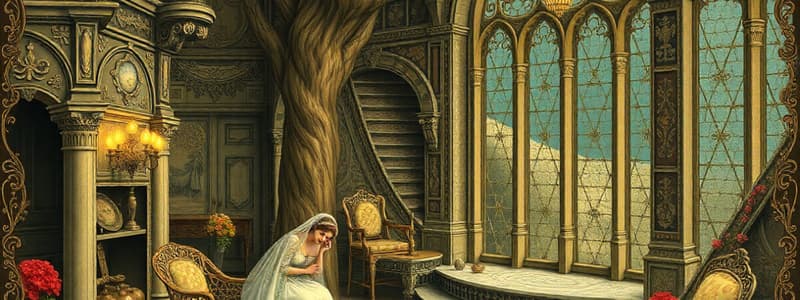Podcast
Questions and Answers
What was the main focus of art during the Pre-Greek Period?
What was the main focus of art during the Pre-Greek Period?
- Mythological themes
- Sea and nature (correct)
- Hunting and war
- Human character expressions
Which period is characterized by the influence of Egyptian art?
Which period is characterized by the influence of Egyptian art?
- Roman Period
- Golden Age
- Hellenistic Period
- First Greek Period (correct)
What is a notable work from the Golden Age of Greek painting?
What is a notable work from the Golden Age of Greek painting?
- The Discus Thrower (Discobolus) (correct)
- The Creation of Adam
- The Last Supper
- The Birth of Venus
The Hellenistic Period in Greek painting emphasizes which theme?
The Hellenistic Period in Greek painting emphasizes which theme?
What was the primary focus of Etruscan painting during 2000-1000 BC?
What was the primary focus of Etruscan painting during 2000-1000 BC?
Which characteristic defines Roman painting from 2000 BC to 400 AD?
Which characteristic defines Roman painting from 2000 BC to 400 AD?
What were the early motifs in Early Christian Art focused on?
What were the early motifs in Early Christian Art focused on?
Which theme was predominantly depicted in Byzantine Art?
Which theme was predominantly depicted in Byzantine Art?
What describes Gothic painting?
What describes Gothic painting?
What was a common stylistic approach in Pre-historic painting?
What was a common stylistic approach in Pre-historic painting?
Flashcards are hidden until you start studying
Study Notes
Pre-Historic Painting (40,000 BC to 9000 BC)
- Paintings often depicted hunting scenes
- Paintings utilized stylistic techniques
Pre-Historic Greek Painting
- Divided into four periods
- Pre-Greek Period: Sea and nature were common motifs
- First Greek Period: Primarily influenced by Egyptian art
- Golden Age (480-400 BC): Focused on representing human character as an expression of divine principles. The Discus Thrower (Discobolus) is a prime example.
- Hellenistic Period (4th century - 1st BC): Painting showcased heightened individualism, tragic moods, and contorted faces.
Etruscan Period (2000-1000 BC)
- Painting subjects included ancestor worship, catacombs, and sarcophagi
Roman Period (2000 BC - 400 AD)
- Characterized by commemorative statues, sarcophagi, frescoes, and vine-motif designs
Medieval Painting
- Divided into three classifications
- Early Christian Art: Symbolism played a key role, including the cross, fish, lamb, dove, grapes, and other religious imagery. Spiritual expression held more importance than physical beauty.
- Byzantine Art: Paintings commonly featured Christ as the Creator and Mary as the Mother of God.
- Gothic Art: Gothic paintings were religious, grotesque, and calmer and more plastic in style.
Studying That Suits You
Use AI to generate personalized quizzes and flashcards to suit your learning preferences.




